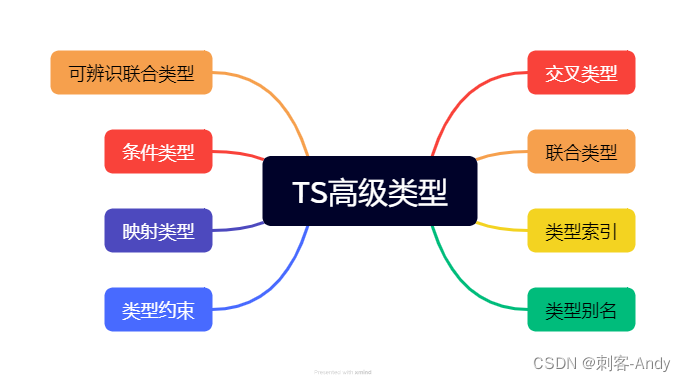前言:为什么需要使用高级类型,正常的类型不能满足日常的业务需求,对于复杂的数据结构、函数签名、类型转换,我们需要使用高级类型来处理,常用的高级类型包含以下几种:

常用的类型定义:
基本类型: 像 number、string、boolean 这样的基本类型,它们表示简单的数据。
对象类型: 可以使用对象字面量、接口、类等定义对象类型。
数组和元组: 具有内置的数组类型和元组类型,用于处理集合数据。
函数类型: 支持函数类型,包括参数类型和返回值类型。
1、交叉类型
是通过 & 符号,将多个类型或者方法合并为一个类型
如:
type Age = {age: number}
type Name = {name: string}
type job = stringtype Person = age & name & job此时 Person 包含了 age name job 的类型
使用于对象合并场景,比如声明一个函数,将两个对象合并为一个对象
<script lang="ts">function extend<T, U>(first:T, second:U): T&U {let result:<T & U> = {}for(let i in first) {result[i] = first[i]}for(let i in second) {if (!result.hasOwnProperty(i)) {result[i] = second[i]}}return result}
</script>
2、联合类型
表示一个值可以是多个类型 中的任意一个,通常使用 | 管道符 表示
type Result = number | string | boolean
Result 的值只能是 number、string、boolean 中的一个,不能同时是两种或多种
3、映射类型
通过 in 关键字做类型的映射,遍历已有类型的key,或者遍历联合类型,通常与泛型一起使用,用于添加修改属性
<script lang="ts">
type Item = {readonly id: string,title:string
}type ReadOnlyItem<T> = {reaonly [key in keyof T]: T[key]
}type NewItem = ReadOnlyItem<Item>// 获取我们希望 自定义的类型在 使用时候是可选的
type Partial<T> = {[P in keyof T]?: T[P];
}
</script>
keyof T:通过类型索引 keyof 的得到联合类型 id | title
P in keyof T 等同于 p in id | title,相当于执行了一次 forEach 的逻辑,遍历 id | title, 从而进行修改获取最新的类型
最后得到的 NewItem为如下:
type NewItem = {readonly id: string,readonly title:string
}
4、条件类型
条件类型允许通过 三元运算的方式 选择不同的类型,通常应用于泛型或者复杂类型
<script lang="ts">T extend U ? E : F // 如果 T是U的子集,那么就取 泛型 E 否则 取 泛型 F// 如定义一个booleantype IsBoolean<T> = T extend boolean ? true : falsetype E = isBoolean<string> // falsetype F = isBoolean<boolean> // true</script>
5、可辨识联合类型
在函数式编程中 我们通常会合并单例类型,联合类型,类型保护和类型别名来创建一个叫做 可辨识联合的高级模式,它也称做 标签联合或 代数数据类型;
通常需要满足 三个要素:
A、具有普通的单例类型属性— 可辨识的特征。
B、一个类型别名包含了那些类型的联合— 联合。
C、此属性上的类型保护。
<script lang="ts">
interface Square {kind: "square";size: number;
}
interface Rectangle {kind: "rectangle";width: number;height: number;
}
interface Circle {kind: "circle";radius: number;
}
// 先声明 三个接口。 每个接口都有 kind属性但有不同的字符串字面量类型。 kind属性称做 可辨识的特征或 标签。 其它的属性则特定于各个接口;
type Shape = Square | Rectangle | Circle;
// 现在我们使用可辨识联合:function area(s: Shape) {switch (s.kind) {case "square": return s.size * s.size; // 正方形面积case "rectangle": return s.height * s.width;case "circle": return Math.PI * s.radius ** 2;}
}// 若我们没有涵盖所有可辨识的类型时,我们希望编译器能够告知我们
// 使用 never 类型 做完整检查
function areaNever(x: never):never {throw new Error("Unexpected object: " + x + "in Area")
}
// area 做如下修改
function area(s: Shape) {switch (s.kind) {case "square": return s.size * s.size; // 正方形面积case "rectangle": return s.height * s.width;case "circle": return Math.PI * s.radius ** 2;default: return areaNever(s)}
}
</script>
6、索引类型
keyof 类似于 Object.keys ,用于获取一个接口中 Key 的联合类型。
<script lang="ts">
interface Button {type: stringtext: string
}type ButtonKeys = keyof Button
// 等效于
type ButtonKeys = "type" | "text"
</script>
7、类型别名
类型别名会给类型起一个新的名字,可以作用于原始值,联合类型,元组以及其它任何你需要手写的类型;起别名是新建一个名字,由于引用那个类型;
可以使用 type SomeName = someValidTypeAnnotation的语法来创建类型别名
<script lang="ts">type age = number | stringconst b: age = true // 不能将类型 true分配给类型“some”const c: age = 'hello' // okconst d: age = 123 // ok// 泛型type Container<T> = { value: T };// 使用类型别名在属性中引用自己type Tree<T> = {value: T;left: Tree<T>;right: Tree<T>;}
</script>
8、类型约束
通过关键字 extend 进行约束,不同于在 class 后使用 extends 的继承作用,泛型内使用的主要作用是对泛型加以约束
<script>
type BaseType = string | number | boolean
// 这里表示 copy 的参数
// 只能是字符串、数字、布尔这几种基础类型
function copy<T extends BaseType>(arg: T): T {return arg
}
</script>
类型约束通常和类型索引一起使用,例如我们有一个方法专门用来获取对象的值,但是这个对象并不确定,我们就可以使用 extends 和 keyof 进行约束。
<script>function getValue<T, K extends keyof T>(obj: T, key: K) {return obj[key]}const obj = { a: 1 }const a = getValue(obj, 'a')
</script>
TypeScript 的高级类型是前端开发中的强大工具,可以帮助我们处理复杂的数据结构、构建类型安全的应用程序和提高代码的可维护性。通过进一步学习交叉类型、联合类型、映射类型、条件类型等,我们可以更好地应用它们在实际项目中





)










)


